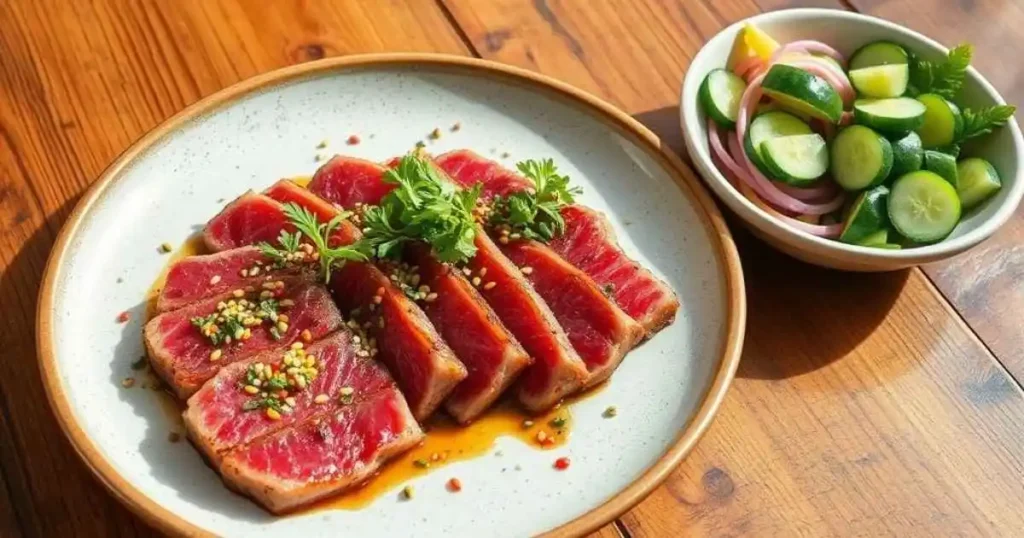I’ve always loved ahi tuna. Its vibrant coral colors, silky texture, and delicious taste have amazed me. Today, I’m excited to share a simple ahi tuna recipe that will delight your taste buds in just 15 minutes. Get ready for a culinary adventure with the freshest, tastiest ahi tuna you’ve ever had.
What is Ahi Tuna and Why Choose It
Ahi tuna, also known as yellowfin tuna, is loved for its high fat content. This makes it firm, buttery, and rich in flavor. Its vibrant red or dark pink color shows it’s fresh and of high quality. Ahi tuna is not just tasty but also packed with protein and omega-3s, great for heart health.
1.Different Types of Tuna
There are many tuna varieties, each with its own charm. Here are a few:
- Bluefin Tuna: A fatty tuna with a deep red color, perfect for sushi and sashimi.
- Albacore Tuna: Known as “white tuna,” it has a mild flavor and lighter color.
- Skipjack Tuna: A smaller, less expensive tuna, often canned or used in tuna salad.
2.Health Benefits and Nutritional Value
Ahi tuna is a powerhouse of protein, with about 26 grams in a 4-ounce serving. It’s also full of omega-3s, which are good for the heart and brain. Plus, it’s rich in vitamins and minerals like vitamin B12 and selenium.
3.Selecting Quality Ahi Tuna
When buying ahi tuna, look for a bright red or dark pink color. This means it’s fresh and of high quality. Stay away from tuna with maroon or brown colors, as they may be old. Also, make sure it’s labeled as “sashimi” or “grill” grade for the best taste.
| Ahi Tuna Grading | Characteristics |
|---|---|
| Grade 1 | Deep red, translucent flesh with a smooth, blemish-free texture and a fresh, oceany aroma. |
| Grade 2 | Slightly less vibrant red color, with a slightly opaque texture and some minor blemishes. |
| Grade 3 | Duller red or pinkish hue, with a more opaque and less appealing texture. |
The quality and freshness of your ahi tuna will greatly affect your dish’s success and taste.
Essential Ingredients for Perfect Ahi Tuna Recipe
Making a tasty ahi tuna Recipe starts with the right ingredients. You need a few key things to get the flavors just right:
- Soy sauce (or tamari for a gluten-free option) – This adds depth and umami to the marinade.
- Toasted sesame oil – A little of this oil brings out the tuna’s natural sweetness.
- Garlic powder – It adds a subtle garlic flavor that goes well with the other tastes.
- Sugar – A bit of sweetness balances the salty and savory flavors.
- Kosher salt and black pepper – These classic seasonings enhance the ahi tuna’s taste.
- Fresh lemon juice – It adds a bright, acidic touch that cuts through the tuna’s richness.
These ingredients make a marinade that brings out the best in the tuna. For searing, use hot oil like canola or vegetable oil to get that nice crust.
| Ingredient | Quantity |
|---|---|
| Ahi tuna steaks | 2 (8 oz each) |
| Soy sauce (or tamari) | 3 tablespoons |
| Toasted sesame oil | 2 teaspoons |
| Garlic powder | 1 teaspoon |
| Sugar | 1 teaspoon |
| Kosher salt | 1/2 teaspoon |
| Black pepper | 1/4 teaspoon |
| Fresh lemon juice | 2 tablespoons |
| Canola or vegetable oil (for searing) | 2 tablespoons |
With these ingredients, you’re ready to make a delicious ahi tuna dish. It’s sure to impress your loved ones.
Kitchen Tools and Equipment Needed
To make a tasty ahi tuna recipe, you’ll need some important kitchen tools. You’ll need a big, heavy skillet, like cast iron or stainless steel. Also, a sharp knife is crucial for cutting the tuna. Don’t use non-stick pans because they can’t sear as well as needed for this recipe.
1. Must-Have Cooking Tools
- Cast iron or stainless steel skillet
- Sharp chef’s knife or sashimi knife
- Cutting board
- Bowl for marinating the tuna
- Kitchen towels for drying the tuna
- Flat, metal spatula for flipping the fish during cooking
2. Optional Kitchen Equipment
- Instant-read thermometer to monitor the tuna’s doneness
- Tongs for easily handling the tuna during searing
- Bamboo sushi rolling mat for shaping and serving poke bowls
- Food processor or high-powered blender for making sauces and marinades
With these tools, you’ll be ready to make a delicious ahi tuna recipe. It will impress everyone. The most important tools are a cast iron skillet and a sharp knife.
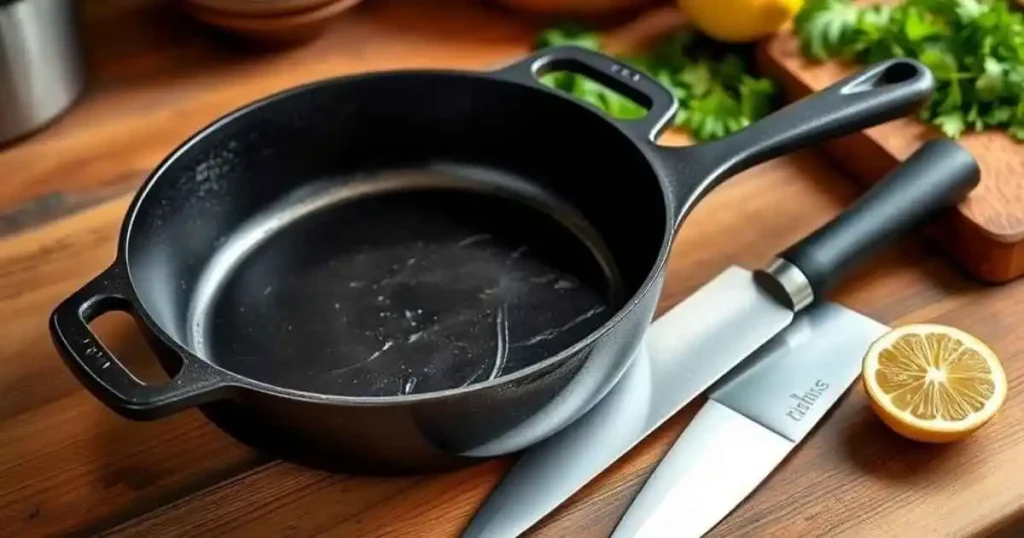
Preparing Your Ahi Tuna recipe for Cooking
To get your ahi tuna recipe ready for cooking, follow these easy steps. First, dry the tuna steaks with paper towels to remove excess moisture. This step helps create a great sear on the outside.
Next, put the dried tuna in a glass or ceramic dish. Coat it evenly with your chosen marinade. The marinade is key, as it adds amazing flavor. A classic mix includes citrus juice, soy sauce, olive oil, garlic, herbs, and spices.
- Cover the dish tightly and refrigerate the tuna for several hours, or up to overnight. Turn the fish at least once during marinating.
- Before cooking, remove any extra marinade from the tuna steaks. This step helps get that perfect sear and caramelized crust.
With your ahi tuna ready and marinated, you’re set for cooking. Make sure you have all your kitchen tools and equipment ready for a smooth cooking experience.
| Marinade Ingredients | Quantity |
|---|---|
| Orange Juice | ¼ cup |
| Soy Sauce | ¼ cup |
| Olive Oil | 2 tablespoons |
| Fresh Parsley | 1 tablespoon, chopped |
| Lemon Juice | 1 tablespoon |
| Garlic, minced | 1 clove |
| Fresh Oregano | ½ teaspoon |
| Black Pepper | to taste |
Classic Ahi Tuna Recipe -seared
Learn the secret to perfectly seared ahi tuna with this classic recipe. The key is the right cooking temperature and technique. Follow our guide to make a seared ahi tuna that will excite your taste buds.
1. Basic Marinade Instructions
Begin by marinating your ahi tuna steaks in a mix of soy sauce, sesame oil, and honey. Let the tuna soak in these flavors for at least 30 minutes before cooking.
2. Cooking Temperature Guidelines
To get the best seared ahi tuna recipe, heat your skillet or grill to 400°F to 450°F. This high heat is crucial for a seared outside and a rare, tender inside.
3. Step-by-Step Preparation
- Pat the ahi tuna steaks dry with paper towels and season with salt and pepper.
- Heat a heavy-duty skillet or grill pan over high heat until it’s almost smoking.
- Add a tablespoon of high-quality cooking oil to the pan and swirl to coat.
- Carefully place the tuna steaks in the hot pan and sear for 1.5 minutes per side for 1.5-inch thick pieces, or 1 minute per side for thinner cuts.
- The center of the tuna should remain pink for optimal taste and texture.
- Remove the seared tuna from the heat and let it rest for 10 minutes before slicing thinly across the grain.
- Serve the seared ahi tuna warm, at room temperature, or chilled with your favorite garnishes, such as sliced avocado, pickled ginger, or a drizzle of soy sauce.
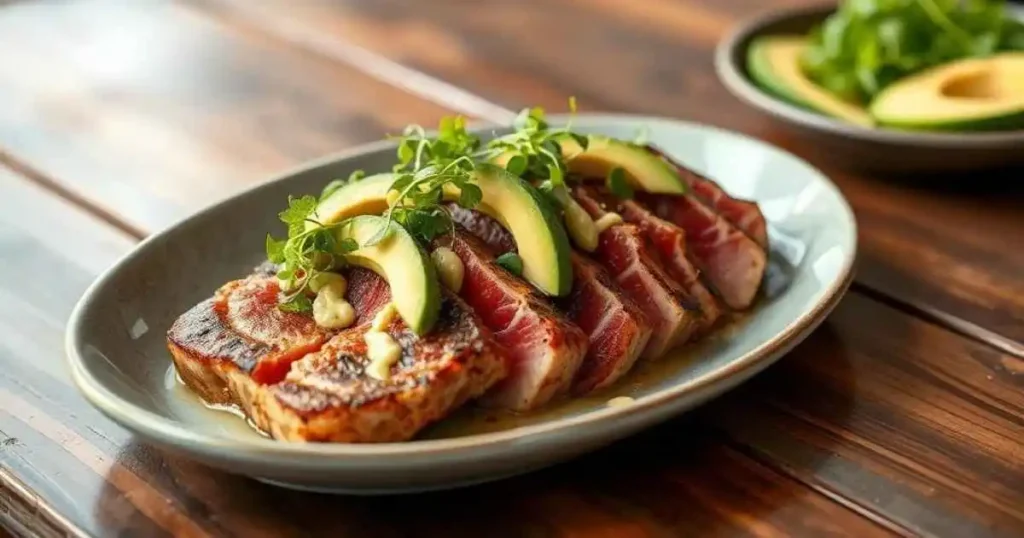
With this classic ahi tuna recipe, you can make restaurant-quality dishes at home. Enjoy the perfect balance of a seared outside and a tender, rare inside in every bite.
Flavor Variations and Marinades
Ahi tuna offers endless flavor possibilities. The classic seared ahi tuna recipe is loved by many. But, feel free to try new seasonings and marinades for unique lunch dishes.
For a tasty twist, try a ginger soy marinade. Mix minced ginger, soy sauce, rice vinegar, and a bit of honey or maple syrup. This creates a sweet and savory taste. You can also use fresh minced garlic instead of garlic powder for a stronger flavor.
- For a spicy kick, add sriracha or your favorite hot sauce. Mix it with mayonnaise or Greek yogurt for creaminess.
- Add toasted sesame seeds on top of the tuna for a nutty crunch.
- Finish with fresh lime juice and chopped cilantro for a bright, herbaceous flavor.
Ahi tuna is incredibly versatile. Don’t hesitate to explore ahi tuna marinade variations and tuna seasoning to discover your favorite flavors. Have fun experimenting and enjoy the delicious outcomes!
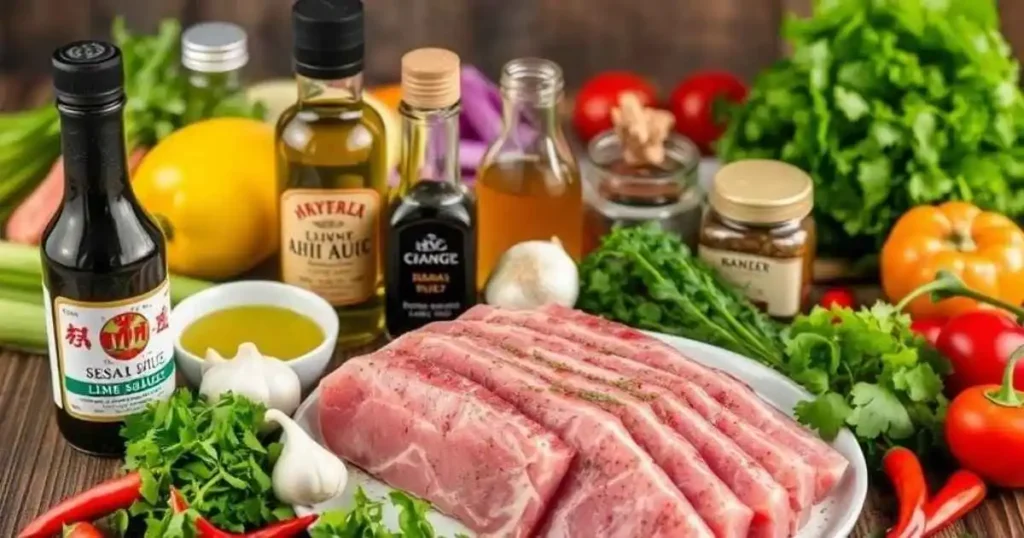
Proper Cooking Techniques and Tips
Getting the perfect sear on ahi tuna is crucial for its great taste and texture. To master searing ahi tuna, focus on temperature control and timing.
1. Temperature Control
Make sure your pan or grill is extremely hot before adding the tuna. The best temperature is 400-450°F (200-230°C). This high heat will give a nice caramelized crust on the outside and a rare to medium-rare inside.
Use a heavy, well-oiled skillet or grill grates for even heat. Don’t overcrowd the pan, as it can steam instead of sear. If needed, cook in batches to keep the temperature right.
2. Timing Guidelines
- Sear the tuna for 1.5 minutes per side for a rare to medium-rare doneness.
- If you prefer a more well-done tuna, increase the searing time to 2-3 minutes per side.
- After searing, let the tuna rest for 3-5 minutes before slicing. This allows the juices to redistribute, resulting in a more tender and flavorful bite.
Remember, the key to perfectly cooked ahi tuna is to avoid overcooking. The center should remain cool and pink, with a delicate, buttery texture. By mastering temperature control and timing, you’ll be able to create restaurant-quality ahi tuna recipe at home.
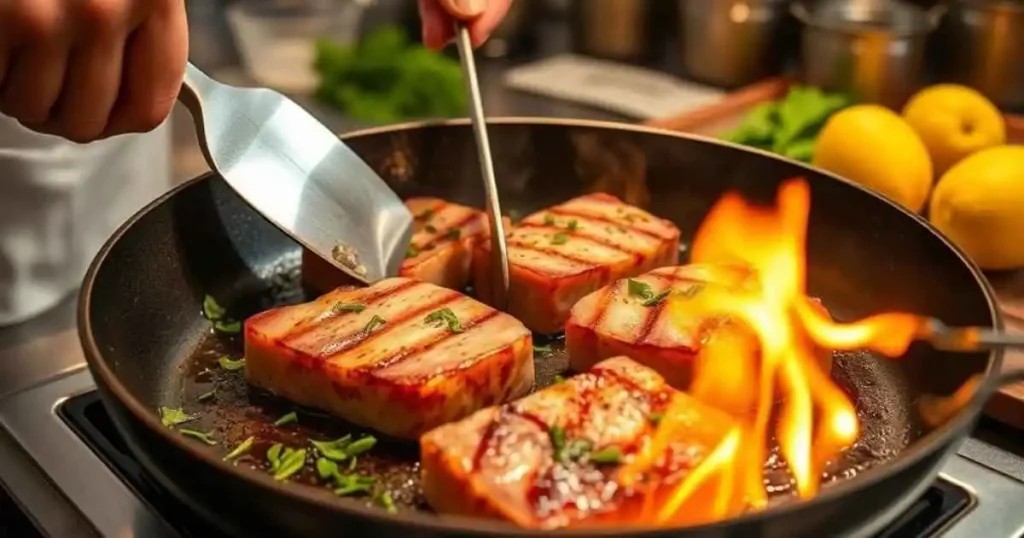
Serving Suggestions and Pairings
When serving your perfectly seared ahi tuna, you have many options to make it even better. Try pairing it with Asian-inspired sides. These will highlight the tuna’s sweetness and richness.
- Serve the ahi tuna over steamed edamame for a protein-rich dish.
- Make an Asian rice salad with crunchy veggies, sesame seeds, and a tangy dressing.
- Top a crisp Asian cabbage slaw or ramen-style salad with the seared ahi tuna.
For drinks, a chilled Riesling or a refreshing pineapple margarita pairs well. They complement the ahi tuna’s bold taste.
Finish with toasted sesame seeds, chopped cilantro, or green onions on top. For more flavor, try sriracha mayo or ponzu sauce.
Ahi tuna recipe is very versatile. You can try different flavors and styles. The goal is to let the tuna’s natural taste shine while adding complementary ingredients and textures.
Storage and Food Safety Guidelines
Enjoying ahi tuna’s fresh flavors is a joy. But, it’s important to store and handle it safely. This ensures your meal stays top-notch. Here are some easy tips for ahi tuna storage and seafood safety.
For the best taste, eat seared ahi tuna the same day. If you have leftovers, wrap them well and refrigerate for a day. When using frozen ahi tuna, thaw it in the fridge for 24 hours. This keeps its texture and taste great.
Food safety is key when dealing with raw or rare fish like ahi tuna. Buy your ahi tuna from trusted, high-quality sources. This guarantees you get the freshest, safest seafood for your dishes.
By sticking to these ahi tuna storage and seafood safety tips, you can enjoy ahi tuna many times. You’ll do so with confidence and a happy taste.
I’m delighted to share this ahi tuna recipe with you, with the hope it becomes a favorite in your routine.
Common Mistakes to Avoid
Preparing ahi tuna recipe can be a fun cooking adventure. But, it’s important to avoid common mistakes to keep the dish tasty and tender. Knowing these mistakes will help you make ahi tuna that’s always a hit.
1. Temperature Errors
Temperature control is key when cooking ahi tuna. If you overcook it, the tuna will be dry and tough. You want to sear the outside and keep the inside juicy and pink. Keep an eye on the temperature to get the perfect texture.
2. Seasoning Mistakes
Seasoning is important to bring out the tuna’s natural flavors. Don’t overdo it, as too much seasoning can mask the taste. Pat the tuna dry before seasoning to help the flavors stick and get a nice crust.
| Common Ahi Tuna Cooking Mistakes | Solutions |
|---|---|
| Overcooking the tuna | Carefully monitor the cooking temperature and time to prevent dryness and chewiness |
| Improper seasoning | Pat the tuna dry before seasoning to allow the spices to adhere properly and achieve a good sear |
| Overmarinating the tuna | Limit the marinade time to overnight at most to avoid compromising the fish’s texture |
By avoiding these common ahi tuna cooking mistakes and tuna preparation errors, you’ll get better at making this tasty seafood. Paying attention to details and using a gentle touch will make your ahi tuna dishes always fresh and delicious.
Alternative Cooking Methods
While searing is a classic and delicious way to prepare ahi tuna, don’t be afraid to explore alternative cooking methods. Two popular options are grilling and blackening the tuna steaks.
1.Grilled Ahi Tuna
Grilling ahi tuna adds a smoky, charred flavor. This flavor complements the tender, buttery texture of the fish. Brush the tuna steaks lightly with oil and season with your desired spices or marinades.
Grill over high heat for 2-3 minutes per side. This depends on the thickness of the steaks and your preferred doneness.
2.Blackened Ahi Tuna
For a Cajun-inspired twist, try blackening your ahi tuna. Coat the tuna steaks in melted butter and a bold Cajun seasoning blend. Then, sear them in a hot skillet until a crispy, blackened crust forms.
Adjust the cooking time based on the thickness of the steaks and your desired level of doneness.
Both grilling and blackening offer unique flavor profiles while maintaining the tuna’s tender, juicy texture. Experiment with different seasonings, marinades, and cooking times to find your perfect grilled ahi tuna or blackened ahi tuna recipe.
Conclusion
Cooking ahi tuna at home lets you enjoy a top-notch meal in no time. You can make a tasty, healthy, and impressive dish with the right steps. Try different flavors and cooking ways to find your favorite ahi tuna recipe.
Whether you like a simple seared ahi tuna or something new, knowing ahi tuna’s special traits is key. Follow the best tips for ahi tuna recipes and seafood prep. This way, you can make your meals better and wow your loved ones.
Always keep food safety and storage tips in mind to keep your ahi tuna fresh. With practice and the right methods, you’ll make ahi tuna dishes that taste great and look good. Explore the world of ahi tuna and find your own special recipe.
Frequently Asked Questions
What is ahi tuna and why is it a popular choice?
Ahi tuna, also known as yellowfin tuna, is loved for its high fat content. This makes it firm and buttery. It’s also packed with protein and omega-3s, making it a healthy choice.
How do I select quality ahi tuna ?
Look for ahi tuna with a bright red or dark pink color. Avoid any with maroon or brown. Make sure it’s sashimi or grill grade for the best taste.
What are the key ingredients for an ahi tuna marinade?
For a tasty ahi tuna dish, use soy sauce or tamari for a gluten-free option. Add Asian toasted sesame oil, garlic powder, sugar, kosher salt, black pepper, and fresh lemon juice.
What kitchen tools are needed for preparing ahi tuna recipe?
You’ll need a large, heavy skillet, like cast iron or stainless steel. Also, a sharp knife and a cutting board are essential. Don’t use non-stick pans for searing.
How should I prepare the ahi tuna before cooking?
Dry the tuna steaks well with paper towels. Place them in a dish and coat with marinade. Cover and refrigerate for several hours or overnight.
What is the proper technique for searing ahi tuna?
Heat oil in a skillet until it smokes. Sear tuna steaks for 1.5 minutes per side for 1.5-inch thick pieces. For thinner cuts, sear for 1 minute per side. The center should stay pink for the best taste and texture.
Can I experiment with different marinade variations?
Yes, you can try different marinades. Use a ginger soy marinade or fresh minced garlic instead of garlic powder. Try honey or maple syrup for a different sweetness.
How should I store leftover seared ahi tuna?
Eat seared ahi tuna on the day it’s prepared for the best taste. If you have leftovers, wrap them tightly and refrigerate for up to a day. Thaw frozen tuna in the fridge for 24 hours before cooking.
What are some common mistakes to avoid when cooking ahi tuna?
Don’t overcook the tuna or marinate it too long. Make sure to dry the tuna well before searing. Also, heat the pan well before searing to get a good crust.
Are there any alternative cooking methods besides searing?
Yes, you can grill or blacken ahi tuna. For blackened tuna, coat the fish in melted butter and Cajun spices before searing in a hot skillet.

